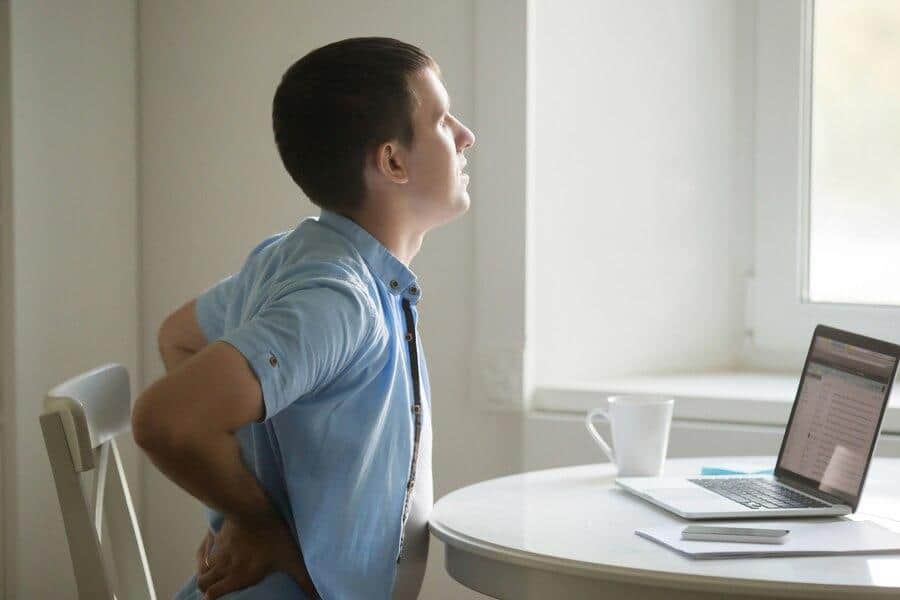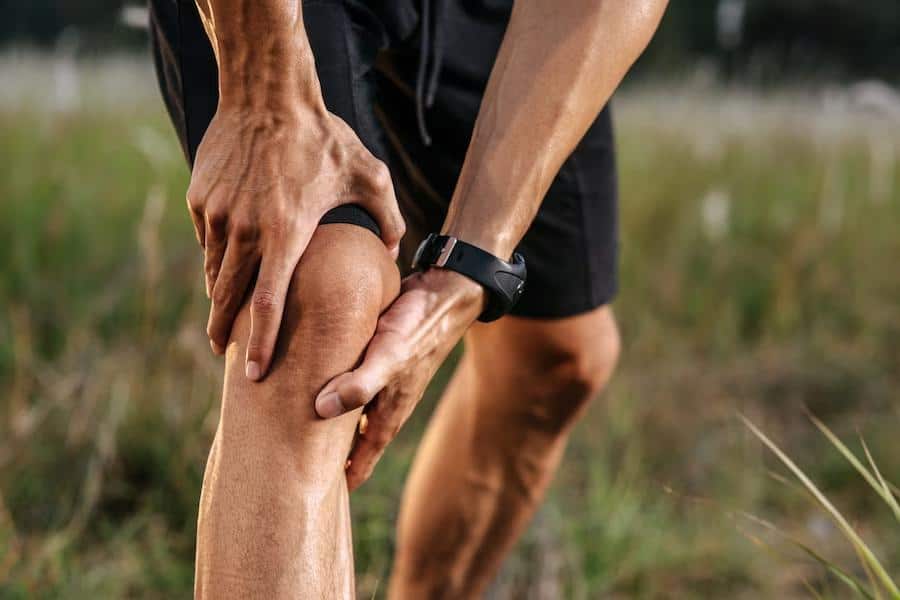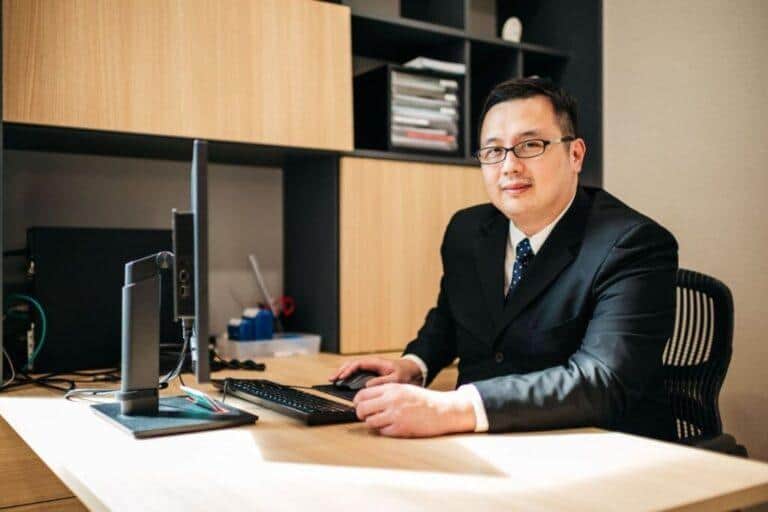Lower back and knee pain significantly impact the quality of life for those suffering from them. There are several treatment options available, ranging from less invasive to more extreme measures, that help manage these conditions. This discussion will focus on commonly used therapies for alleviating back and knee pain.
Comprehending the Pain
(Source:https://www.freepik.com/free-photo/profile-portrait-man-laptop-stretching-backache-position_1281138.htm#page=2&query=lower%20back%20pain&position=44&from_view=search&track=ais)
Lower back pain can torment individuals, causing them to adjust their mobility and potentially putting other body parts at risk. This can increase knee pain and restrict movement and flexibility, worsening spinal discomfort. Tight hamstring muscles frequently contribute to knee pain, leading to injury and further spinal problems for those affected. Moreover, if someone already has difficulty walking due to knee pain, it can strain the lower back even more, resulting in additional discomfort.
Here are several conditions correlated with lower back and knee pain:
The affliction known as sciatica, influences the sciatic nerve. This nerve holds vital sway over muscle command in the lower limb and knee, as well as sensation in certain leg regions. Sciatica often leads to sharp pain or a feeling of weakness starting in the lower back and spreading through one leg, making it quite uncomfortable for people experiencing it.
Arthritis is mainly of two kinds: osteoarthritis and rheumatoid arthritis. These can make your joints hurt and swell, and it’s something you might see more often as you get older or if you’ve been really active. This may lead to spinal pain when walking becomes challenging.
Studies suggest that a notable fraction of the populace will encounter back pain episodes, typically due to physical injury or prolonged periods of suboptimal posture, especially while seated at a workstation. Observations have also shown that spinal pain frequently precedes knee pain in individuals over 50, indicating a clear correlation between the two maladies. Moreover, it has been observed that spinal pain often heralds knee pain in people aged 50 and above – suggesting a connection between these issues.
(Source:https://www.freepik.com/free-photo/man-bent-her-head-grabbed-him-her-after-exercise_8351815.htm#query=knee%20arthritis&position=2&from_view=search&track=ais)
Treatments for Lower Back Pain
Lower back pain is a pretty common problem, and luckily, there’s more than one way to deal with it. Treatment options can be medicine, making better health choices, physio, ways to handle pain, and even surgery if nerves are squished or spines need to be steadier.
Treatments for Knee Pain
Making sure you deal with your knee pain the right way is important. There’s a bunch of choices you’ve got. This could be going for an operation or trying out minimally invasive treatments. Changing up how you live day to day could make you feel better. Wearing a knee brace can help hold everything in place. If moving around is tough, physical therapy can get you going again. If you play sports and have a bad ligament, surgery could fix it, while another kind of surgery, called arthroscopic, is good for fixing torn knee parts like meniscus or cartilage. If arthritis has really messed up your knee, you might need to get the whole knee replaced. What you go for all depends on what you personally need and the state of your knee.
Conservative Treatment Options
Physiotherapy
Physiotherapy is a helpful way to treat people who have back and knee pain. Therapists use special exercises, hands-on methods, and things like heat and cool packs to ease pain and help patients move better. Studies show that physiotherapy is good at lowering long-lasting back pain. This custom, gentle way really tackles pain and helps a person feel better all around.
Exercise
Making exercise a part of your daily life is a great way to help ease pain in your back or knees. When you stay active, your muscles get stronger, you become more flexible, and swelling in those sore spots can go down. A lot of research points to the fact that folks with constant back pain feel a lot better when they exercise regularly. It’s a handy and smart way to take care of your health.
Weight Loss
Starting a journey to lose weight can help ease back and knee pain, which is particularly helpful for people with osteoarthritis. Carrying extra pounds adds more strain on the joints, which can make pain and swelling worse. Research that looked closely at different studies found that when adults with arthritis in their knees lose weight, they have less pain and can move better. Getting to a healthier weight is really good for people with pain in their joints. It can help you move more easily, hurt less, and overall, just make you feel a whole lot better. If joint pain is a problem for you, shedding some pounds could really improve your life.
Medications
If you’re dealing with back or knee pain, there are several medicines that can help ease your discomfort. You can get Nonsteroidal Anti-Inflammatory Drugs (NSAIDs) without a prescription, and they’re good at bringing down both pain and swelling. You can also pick up Acetaminophen from the drugstore; it doesn’t fight inflammation, but it can help with the pain. If you have really bad pain, doctors might suggest opioids. These are strong and can be habit-forming, so it’s important to use them just like a doctor tells you to.
Invasive Treatment Options
Injections
Back and knee pain can really put a damper on your day, but getting shots right in the sore spot can help a lot! This helps with pain and swelling. But remember, this isn’t a do-it-yourself kind of thing—you’ll need a professional who knows what they’re doing to give you these shots. Also, your doctor should check you out first to make sure this treatment is right for you.
When it comes to treating sore knees, doctors have a few different types of shots they can use. Corticosteroid shots are common for bringing down swelling and pain in the knee for a short time. Hyaluronic acid shots help by using a substance that’s naturally found in our joints to make them slide smoothly and hurt less. There’s also something called PRP, or platelet-rich plasma, where they take some of your own blood that’s full of special cells called platelets and put it back into your knee. These platelets are like tiny healers that can help fix the damage and calm down the swelling.
Surgery
If you’ve tried many treatments for back or knee pain but still hurt, surgery might be the next step to think about. For back pain, one surgery type is called spinal fusion, and for knee pain, there’s a surgery called total knee replacement.
Spinal fusion and knee replacement surgeries are done to help with different kinds of pain. In spinal fusion, doctors join the bones in the back together to help with pain from worn-out discs or a narrow spine. Knee replacement surgery puts in a fake knee joint to take care of really bad knee pain from arthritis.
Healthcare providers have a range of management options for spinal and patellar discomfort. These include conservative methods like physiotherapy and exercise, as well as more invasive interventions such as injections and surgery. The appropriate treatment mode depends on factors like the cause of the pain, its severity, and the patient’s overall health condition and preferences. Collaboration with a healthcare provider is essential to create a personalized treatment plan that aligns with individual needs.
Frequently asked questions:
What causes lower back and knee pain, and why do they often occur together? Muscle strains, arthritis, injuries and poor posture often cause the simultaneous occurrence of lower back and knee pain. This is primarily due to their close anatomical connection.
Are there any lifestyle changes I can make to alleviate lower back and knee pain? Adopting a healthy lifestyle indeed provides assistance: maintaining good posture; regular exercise; avoidance of heavy lifting, and weight management – these collectively reduce stress on your joints.
What non-invasive treatments can I try before considering surgery? Explore physical therapy, pain medications, lifestyle modifications and hot/cold therapy; these methods frequently offer non-surgical relief.
When is surgery necessary for lower back and knee pain? When conservative treatments prove ineffective, or in the presence of structural issues such as herniated discs or severe arthritis, surgery becomes a viable consideration. A specific assessment of your condition will be conducted by your doctor.
How can I determine which treatment options are best for my specific condition? Consult with a healthcare provider; they will assess your condition, review past medical records–and understand your objectives: this aids in the creation of a personalized treatment plan.
What role does exercise play in managing lower back and knee pain? Exercise fortifies muscles; enhances flexibility and mitigates pain. It is an indispensable aspect of our well-being.
Are there any long-term strategies to prevent recurring lower back and knee pain? Maintaining a healthy lifestyle through regular exercise and ongoing self-care indeed prevents recurrent pain. Essential to this endeavor are proper ergonomics and weight management–two factors that should not be overlooked.
References:
- https://www.mayoclinic.org/diseases-conditions/knee-pain/diagnosis-treatment/drc-20350855
- https://www.medicalnewstoday.com/articles/lower-back-and-knee-pain
- https://www.sciatica.com/from-the-doc/9-treatment-options-for-lower-back-pain/
Dr Yong Ren’s Profile
Dr Yong Ren graduated from the National University of Singapore’s Medical faculty and embarked on his orthopaedic career soon after. Upon completion of his training locally, he served briefly as an orthopaedic trauma surgeon in Khoo Teck Puat hospital before embarking on sub-specialty training in Switzerland at the famed Inselspital in Bern.
He underwent sub-specialty training in pelvic and spinal surgery, and upon his return to Singapore served as head of the orthopaedic trauma team till 2019. He continues to serve as Visiting Consultant to Khoo Teck Puat Hospital.
Well versed in a variety of orthopaedic surgeries, he also served as a member of the country council for the local branch of the Arbeitsgemeinschaft für Osteosynthesefragen (Trauma) in Singapore. He was also involved in the training of many of the young doctors in Singapore and was appointed as an Assistant Professor by the Yong Loo Lin School of Medicine. Prior to his entry into the private sector, he also served as core faculty for orthopaedic resident training by the National Healthcare Group.
Dr Yong Ren brings to the table his years of experience as a teacher and trainer in orthopaedic surgery. With his expertise in minimally invasive fracture surgery, pelvic reconstructive surgery, hip and knee surgery as well as spinal surgery, he is uniquely equipped with the tools and expertise necessary to help you on your road to recovery.






